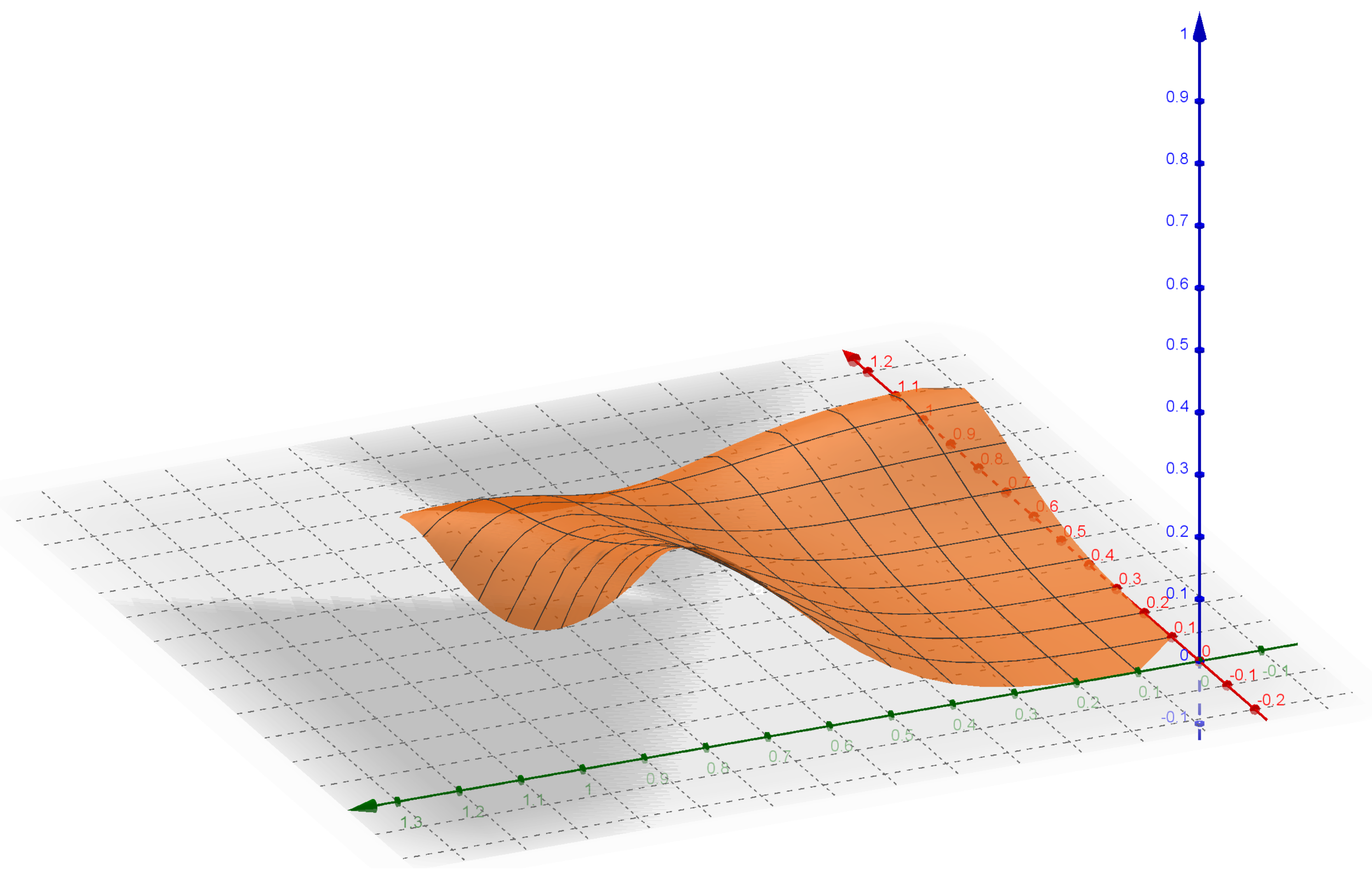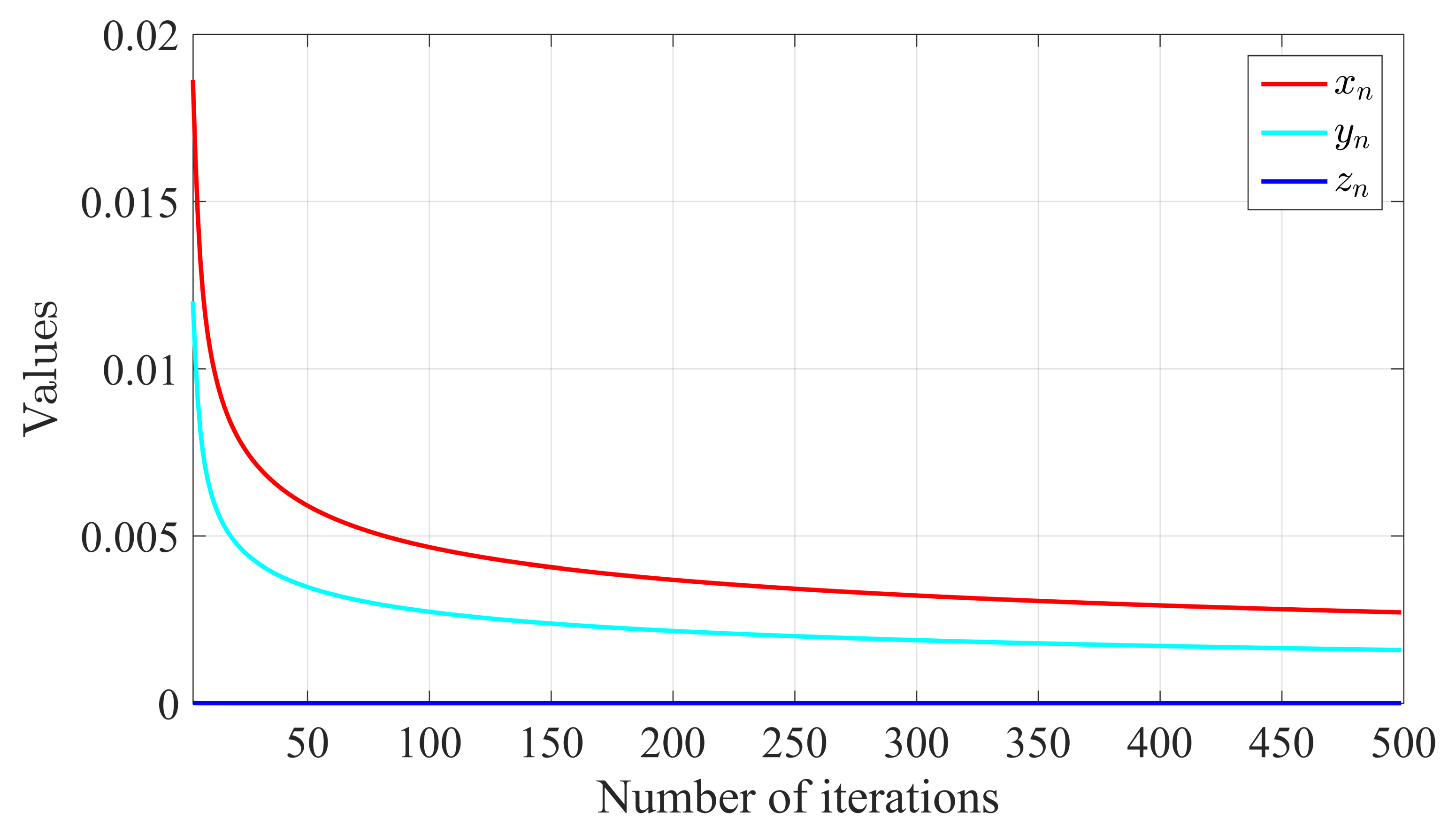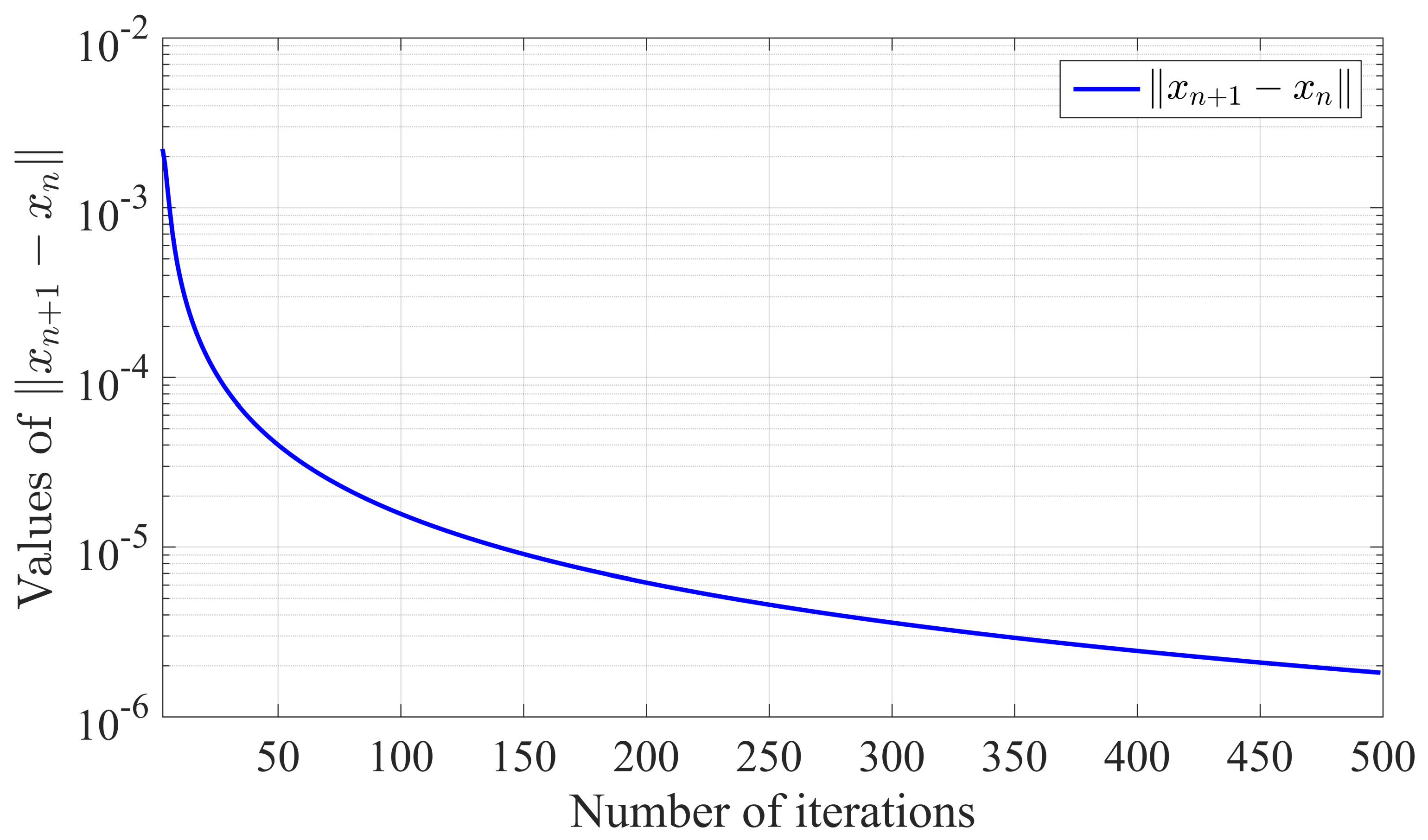Approximating Fixed Points of Bregman Generalized α-Nonexpansive Mappings
Abstract
1. Introduction
- nonexpansive if
- quasi-nonexpansive if and
- α-nonexpansive, where , if
- Bregman nonexpansive if
- Bregman quasi-nonexpansive if and
- Bregman skew quasi-nonexpansive if and
- Bregman nonspreading if
2. Preliminaries
- A Banach space E is said to be strictly convex if whenever and .
- The space E is also said to be uniformly convex if, for all there exists such that and imply .
- A Banach space E is said to be smooth ifexists for all .
- (1)
- Every uniformly convex Banach space is strictly convex and reflexive.
- (2)
- A Banach space E is uniformly convex if and only if is uniformly smooth.
- (3)
- If E is reflexive, then E is strictly convex if and only if is smooth (see, for instance, Takahashi [18] for more details).
- For any the gradient of f is defined to be the linear functional in such that
- The function f is said to be Gâteaux differentiable at x if for all . In this case, we denote by .
- The function f is also said to be Fréchet differentiable at x if, for all there exists such that implies (see [6])
- A convex function is said to be Gâteaux differentiable on E (Fréchet differentiable on E, respectively) if it is Gâteaux differentiable everywhere (Fréchet differentiable everywhere, respectively).
- A function is said to be strongly coercive if, for any sequence such that converges to ∞, we have
- It is also said to be bounded on bounded sets if is bounded for each Let be the unit sphere of
- A function is said to be uniformly convex on bounded sets [23] (pp. 203, 221) if for all , where is called the uniform convexity of f defined by
- (a)
- f is continuous, strictly convex and Gâteaux differentiable;
- (b)
- the set is bounded for all and
- 1.
- is one-to-one, onto and norm-to- continuous.
- 2.
- if and only if
- 3.
- is bounded for all y in E and
- 4.
- dom is Gâteaux differentiable function and
- 1.
- f is bounded and uniformly smooth on bounded sets;
- 2.
- f is Fréchet differentiable on dom f and is uniformly continuous on bounded sets;
- 3.
- is strongly coercive and uniformly convex on bounded sets.
- 1.
- f is strongly coercive and uniformly convex on bounded sets;
- 2.
- is bounded and uniformly smooth on bounded sets;
- 3.
- is Fréchet differentiable on dom and is uniformly continuous on bounded sets.
- 1.
- for all and
- 2.
- for all and
- The Bregman asymptotic radius of relative to C is defined by
- The Bregman asymptotic center of relative to C is defined by
- 1.
- i.e., μ is a mean on
- 2.
- The inequalitieshold for each
- If and for each then
- If for each , then
- (a)
- and or, equivalently,
- (b)
- or
3. The Main Results
3.1. Approximating Fixed Points
3.2. Weak and Strong Convergence Theorems for Bregman Generalized -Nonexpansive Mappings
- (a)
- for all
- (b)
- (c)
- 1.
- for all and
- 2.
- exists for any
- 1.
- If is bounded and then
- 2.
- If , then is bounded.
3.3. Bregman Noor’s Type Iteration for Bregman Generalized -Nonexpansive Mappings
- 1.
- for all and .
- 2.
- exists for any
- 1.
- There exists a bounded sequence generated by equations (16) such that
- 2.
- The fixed point set
- (a)
- (b)
- (c)
4. Numerical Examples
5. Conclusions
Author Contributions
Funding
Acknowledgments
Conflicts of Interest
References
- Bregman, L.M. The relaxation method of finding the common point of convex sets and its application to the solution of problems in convex programming. USSR Comput. Math. Math. Phys. 1967, 7, 200–217. [Google Scholar] [CrossRef]
- Bauschke, H.; Borwein, J. Legendre functions and the method of random Bregman projections. J. Convex Anal. 1997, 4, 27–67. [Google Scholar]
- Butnariu, D.; Resmerita, E. Bregman distances, totally convex functions and a method for solving operator equations in Banach spaces. Abstr. Appl. Anal. 2006, 2006, 1–39. [Google Scholar] [CrossRef]
- Suantai, S.; Cho, Y.; Cholamjiak, P. Halpern’s iteration for Bregman strongly nonexpansive mappings in reflexive Banach spaces. Comput. Math. Appl. 2012, 64, 489–499. [Google Scholar] [CrossRef]
- Hussain, N.; Naraghirad, E.; Alotaibi, A. Existence of common fixed points using Bregman nonexpansive retracts and Bregman functions in Banach spaces. Fixed Point Theory Appl. 2013, 113, 1–19. [Google Scholar] [CrossRef]
- Kohsaka, F.; Takahashi, W. Proximal point algorithms with Bregman functions in Banach spaces. J. Nonlinear Convex Anal. 2005, 6, 505–523. [Google Scholar]
- Bauschke, H.; Borwein, J.; Combettes, P. Bregman monotone optimization algorithms. SIAM J. Control Optim. 2003, 42, 596–636. [Google Scholar] [CrossRef]
- Bauschke, H.; Combettes, P. Construction of best Bregman approximations in reflexive Banach spaces. Proc. Am. Math. Soc. 2003, 131, 3757–3766. [Google Scholar] [CrossRef]
- Reich, S.; Sabach, S. Two strong convergence theorems for Bregman strongly nonexpansive operators in reflexive Banach spaces. Nonlinear Anal. 2010, 73, 122–135. [Google Scholar] [CrossRef]
- Suzuki, T. Fixed point theorems and convergence theorems for some generalized nonexpansive mappings. J. Math. Anal. Appl. 2008, 340, 1088–1095. [Google Scholar] [CrossRef]
- Pant, R.; Shukla, R. Approximating fixed points of generalized α-nonexpansive mapping in Banach space. Numer. Funct. Anal. Optim. 2017, 38, 248–266. [Google Scholar] [CrossRef]
- Ishikawa, S. Fixed points and iteration of a nonexpansive mapping in a Banach space. Proc. Am. Math. Soc. 1976, 59, 65–71. [Google Scholar] [CrossRef]
- Noor, M.A. New approximation schemes for general variational inequalities. J. Math. Anal. Appl. 2000, 251, 217–229. [Google Scholar] [CrossRef]
- Opial, Z. Weak convergence of the sequence of successive approximations for nonexpansive mappings. Bull. Am. Math. Soc. 1967, 73, 595–597. [Google Scholar] [CrossRef]
- Butnariu, D.; Iusem, A.N. Totally Convex Functions for Fixed Points Computation and Infinite Dimensional Optimization; Pardalos, P.M., Hearn, D., Eds.; Springer Science+Business Media: Dordrecht, The Netherlands, 2000. [Google Scholar]
- Huang, Y.Y.; Jeng, J.C.; Kuo, T.V.; Hong, C.C. Fixed point and weak convergence theorems for point-dependent λ-hybrid mappings in Banach spaces. Fixed Point Theory Appl. 2011, 2011, 105. [Google Scholar] [CrossRef]
- Naraghirad, E.; Wong, N.C.; Yao, J. Applications of Bregman–Opial property to Bregman nonspreading mappings in Banach spaces. Abstr. Appl. Anal. 2014, 1, 1–14. [Google Scholar] [CrossRef]
- Takahashi, W. Nonlinear Functional Analysis, Fixed Point Theory and its Applications; Yokahama Publishers: Yokahama, Japan, 2000. [Google Scholar]
- Pang, C.; Naraghirad, E.; Wen, C. Weak convergence theorems for Bregman relatively nonexpansive mappings in Banach Spaces. J. Appl. Math. 2014, 2014, 1–9. [Google Scholar] [CrossRef]
- Rockafellar, R.T. Characterization of subdifferentials of convex functions. Pac. J. Math. 1966, 17, 497–510. [Google Scholar] [CrossRef]
- Rockafellar, R.T. On the maximal monotonicity of subdifferential mappings. Pac. J. Math. 1970, 33, 209–216. [Google Scholar] [CrossRef]
- Phelps, R. Convex Functions, Monotone Operators, and Differentiability, 2nd ed.; Springer: Berlin, Germany, 1993; Volume 1364. [Google Scholar]
- Zǎlinescu, C. Convex Analysis in General Vector Spaces; World Scientific Publishing Co. Inc.: River Edge, NJ, USA, 2002. [Google Scholar]
- Chen, G.; Teboulle, M. Convergence analysis of a proximal-like minimization algorithm using Bregman functions. SIAM J. Control Optim. 1993, 3, 538–543. [Google Scholar] [CrossRef]
- Naraghirad, E.; Yao, J. Bregman weak relatively nonexpansive mappings in Banach spaces. Fixed Point Theory Appl. 2013, 141, 1–43. [Google Scholar] [CrossRef]
- Reich, S.; Sabach, S. Existence and approximation of fixed points of Bregman firmly nonexpansive mappings in reflexive Banach spaces. In Fixed-Point Algorithms for Inverse Problems in Science and Engineering; Springer: New York, NY, USA, 2010; pp. 299–314. [Google Scholar]
- Maingé, P.E. Strong convergence of projected subgradient methods for nonsmooth and nonstrictly convex minimization. Set-Valued Anal. 2008, 16, 899–912. [Google Scholar] [CrossRef]
- Xu, H.K.; Kim, T.K. Convergence of hybrid steepest-descent methods for variational inequalities. J. Optim. Theory Appl. 2003, 119, 185–201. [Google Scholar] [CrossRef]
- Halpern, B. Fixed points of non-expanding maps. Bull. Am. Math. Soc. 1993, 73, 957–961. [Google Scholar] [CrossRef]
- Reich, S. Weak convergence theorems for nonexpansive mappings in Banch spaces. J. Math. Anal. Appl. 1979, 67, 274–276. [Google Scholar] [CrossRef]
- Takahashi, W.; Kim, G.E. Approximating fixed points of nonexpansive mappings in Banach spaces. Math. Jpn. 1998, 48, 1–9. [Google Scholar]
- Nilsrakoo, W.; Saejung, S. Strong convergence theorems by Halpern-Mann iterations for relatively nonexpansive mappings in Banach spaces. Appl. Math. Comput. 2011, 217, 6577–6586. [Google Scholar] [CrossRef]



| No. of Iterations | ||||
|---|---|---|---|---|
| 1 | 0.0000000 | 0.0000000 | 0.0200000 | 0.0200000 |
| 2 | 0.0000120 | 0.0133887 | 0.0185640 | 0.0014360 |
| 3 | 0.0000085 | 0.0119489 | 0.0163510 | 0.0022130 |
| 4 | 0.0000055 | 0.0103005 | 0.0145690 | 0.0017821 |
| 5 | 0.0000037 | 0.0090538 | 0.0132797 | 0.0012893 |
| 6 | 0.0000027 | 0.0081755 | 0.0123411 | 0.0009386 |
| 7 | 0.0000021 | 0.0075456 | 0.0116283 | 0.0007128 |
| 8 | 0.0000018 | 0.0070726 | 0.0110622 | 0.0005662 |
| 9 | 0.0000015 | 0.0067004 | 0.0105959 | 0.0004662 |
| 10 | 0.0000013 | 0.0063966 | 0.0102015 | 0.0003944 |
| ⋮ | ⋮ | ⋮ | ⋮ | ⋮ |
| 100 | 0.0000001 | 0.0027372 | 0.0046494 | 0.0000157 |
| 200 | 0.0000001 | 0.0021635 | 0.0036871 | 0.0000062 |
| 300 | 0.0000000 | 0.0018873 | 0.0032201 | 0.0000036 |
| 400 | 0.0000000 | 0.0017135 | 0.0029252 | 0.0000024 |
| ⋮ | ⋮ | ⋮ | ⋮ | ⋮ |
| 491 | 0.0000000 | 0.0015998 | 0.0027318 | 0.0000019 |
| 492 | 0.0000000 | 0.0015987 | 0.0027300 | 0.0000019 |
| 493 | 0.0000000 | 0.0015976 | 0.0027281 | 0.0000018 |
| 494 | 0.0000000 | 0.0015965 | 0.0027263 | 0.0000018 |
| 495 | 0.0000000 | 0.0015954 | 0.0027244 | 0.0000018 |
| 496 | 0.0000000 | 0.0015943 | 0.0027226 | 0.0000018 |
| 497 | 0.0000000 | 0.0015933 | 0.0027208 | 0.0000018 |
| 498 | 0.0000000 | 0.0015922 | 0.0027190 | 0.0000018 |
| 499 | 0.0000000 | 0.0015911 | 0.0027171 | 0.0000018 |
© 2019 by the authors. Licensee MDPI, Basel, Switzerland. This article is an open access article distributed under the terms and conditions of the Creative Commons Attribution (CC BY) license (http://creativecommons.org/licenses/by/4.0/).
Share and Cite
Muangchoo, K.; Kumam, P.; Cho, Y.J.; Dhompongsa, S.; Ekvittayaniphon, S. Approximating Fixed Points of Bregman Generalized α-Nonexpansive Mappings. Mathematics 2019, 7, 709. https://doi.org/10.3390/math7080709
Muangchoo K, Kumam P, Cho YJ, Dhompongsa S, Ekvittayaniphon S. Approximating Fixed Points of Bregman Generalized α-Nonexpansive Mappings. Mathematics. 2019; 7(8):709. https://doi.org/10.3390/math7080709
Chicago/Turabian StyleMuangchoo, Kanikar, Poom Kumam, Yeol Je Cho, Sompong Dhompongsa, and Sakulbuth Ekvittayaniphon. 2019. "Approximating Fixed Points of Bregman Generalized α-Nonexpansive Mappings" Mathematics 7, no. 8: 709. https://doi.org/10.3390/math7080709
APA StyleMuangchoo, K., Kumam, P., Cho, Y. J., Dhompongsa, S., & Ekvittayaniphon, S. (2019). Approximating Fixed Points of Bregman Generalized α-Nonexpansive Mappings. Mathematics, 7(8), 709. https://doi.org/10.3390/math7080709






